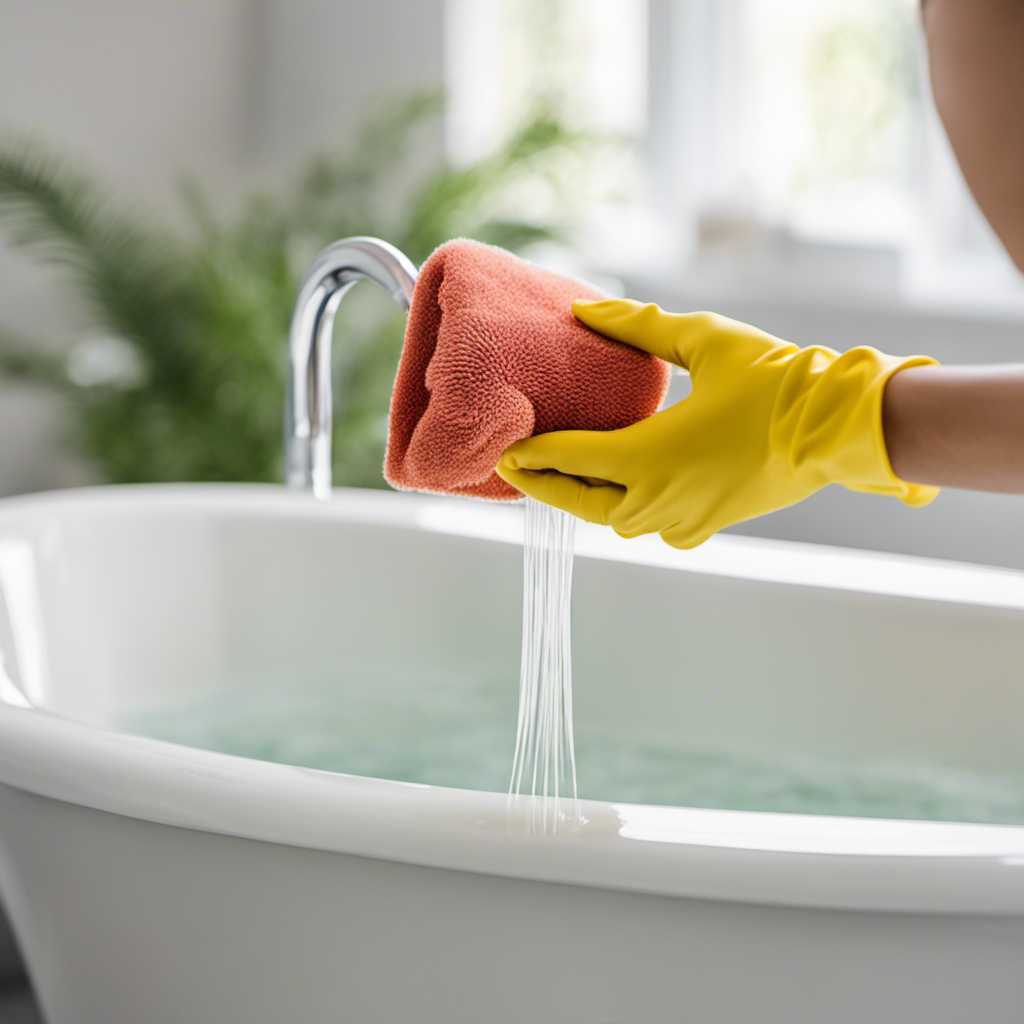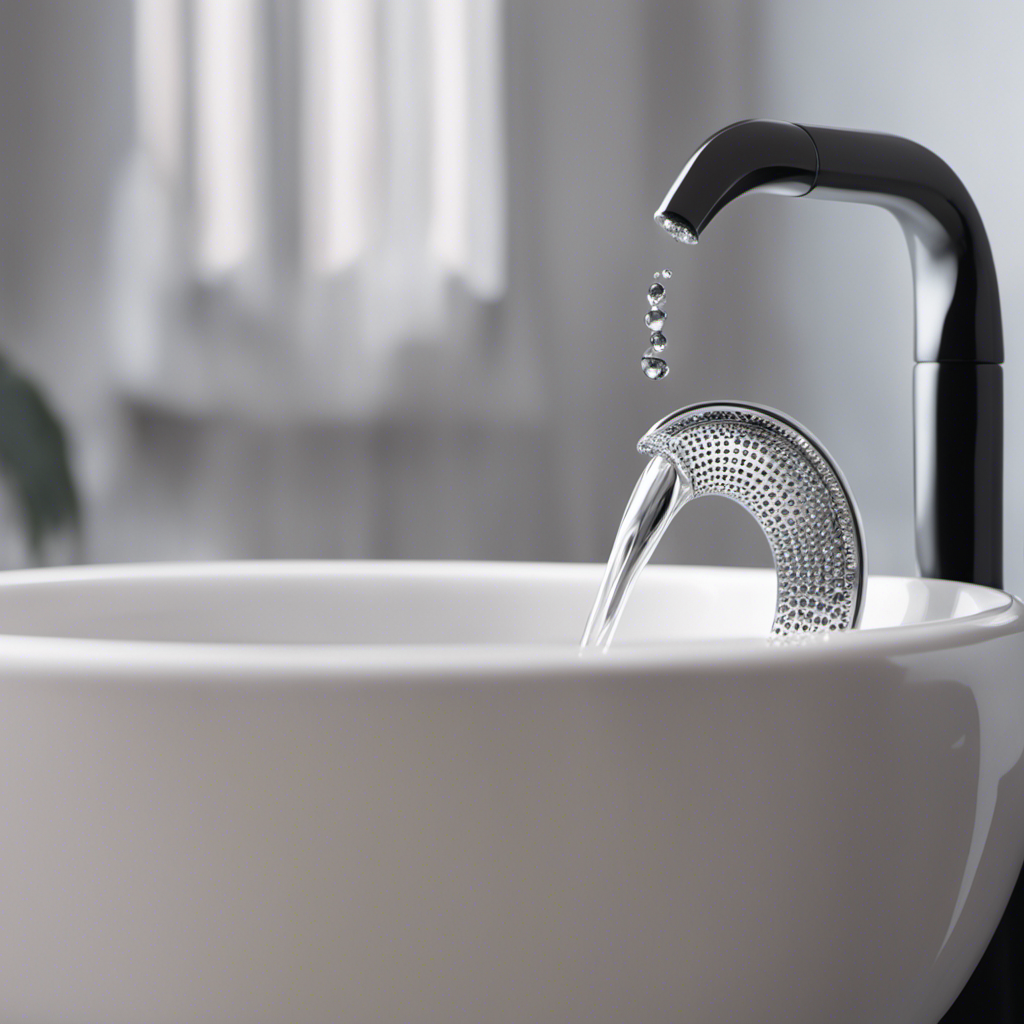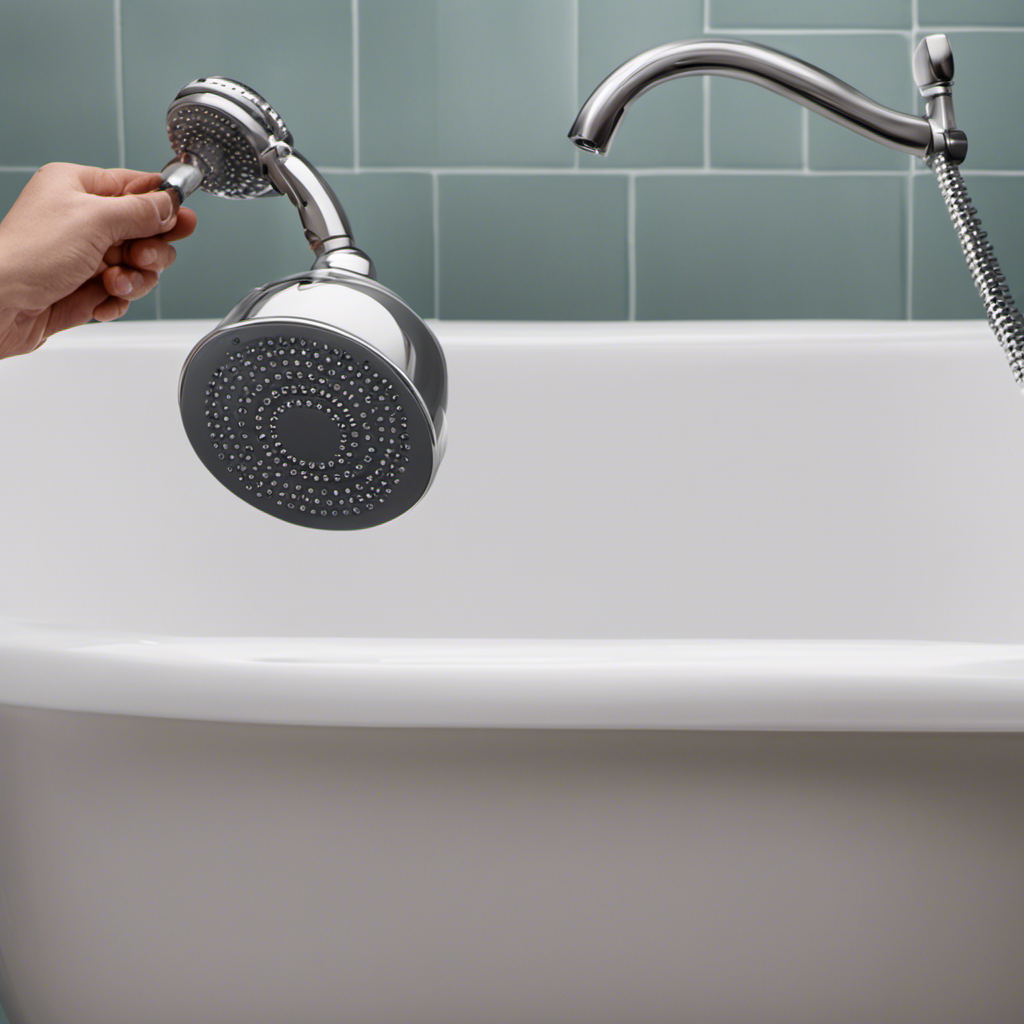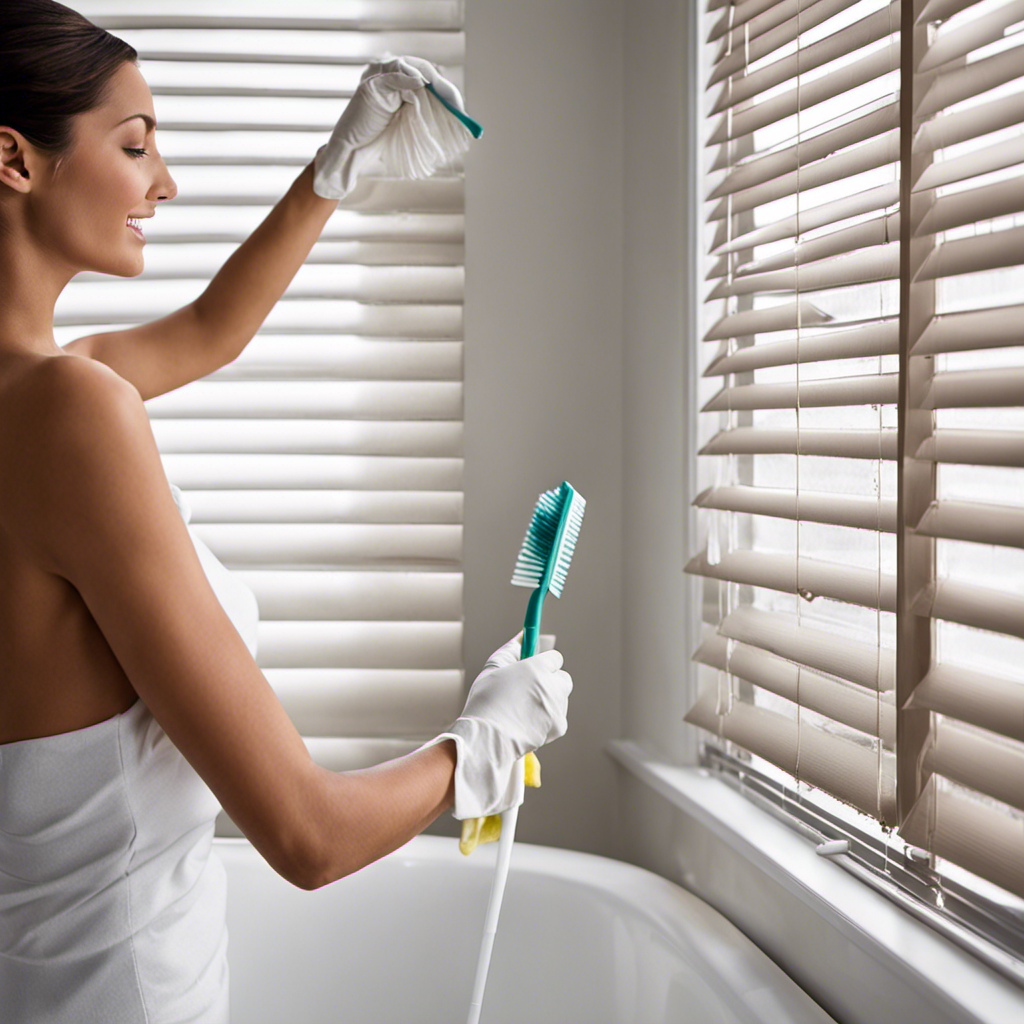I know cleaning bathtub stains can be a daunting task, but I’m here to help!
In this article, I’ll share my step-by-step process for effectively removing those stubborn stains.
From identifying the cause to preparing the cleaning solution, I’ll guide you through each stage.
You’ll also discover natural alternatives and learn how to prevent future stains.
So, let’s dive in and say goodbye to those unsightly bathtub stains once and for all!
Key Takeaways
- Different types of bathtub stains include hard water stains, rust stains, soap scum residue, and mold and mildew stains.
- Identifying the cause of the stains is crucial for selecting the appropriate cleaning method.
- Homemade cleaning solutions like baking soda, vinegar, and hydrogen peroxide can effectively remove stains.
- Consider factors like cost and chemical exposure when deciding between homemade and store-bought cleaners.
Types of Bathtub Stains
There are various types of bathtub stains that can be difficult to remove. Two common types of stains are hard water stains and rust stains.
Hard water stains are caused by minerals in the water, such as calcium and magnesium, which can leave behind a white or cloudy residue on the bathtub surface.
Rust stains, on the other hand, are typically caused by metal objects or fixtures in the bathroom that have corroded over time. These stains appear as reddish-brown marks on the bathtub surface.
Identifying the cause of the stains is important in order to choose the most effective cleaning method. By understanding the type of stain you are dealing with, you can select the appropriate cleaning products and techniques to successfully remove them.
Identifying the Cause of the Stains
To identify what’s causing those pesky stains, you can start by checking for any mineral buildup or soap scum in your bathtub. Here are some common culprits for bathtub stains:
- Hard water: High mineral content in hard water can leave behind unsightly stains on your tub.
- Soap scum: The residue left by soap and body oils can accumulate over time and cause discoloration.
- Rust: If you have metal fixtures in your bathroom, rust can develop and stain your bathtub.
- Mold and mildew: Moisture and lack of ventilation can lead to the growth of mold and mildew, resulting in dark stains.
Identifying the cause of the stains is crucial before you proceed with cleaning. Now that you know what might be causing the discoloration, let’s move on to preparing the cleaning solution.
Preparing the Cleaning Solution
When it comes to cleaning, choosing the right products is essential. In this discussion, we will explore the best cleaning products and compare homemade solutions to store-bought ones.
I will provide information on the effectiveness, cost, and environmental impact of each option to help you make an informed decision.
Best Cleaning Products
I’ll recommend the best cleaning products for removing bathtub stains. Here are my top picks:
-
Baking Soda: This versatile cleaner can be used on its own or mixed with water to create a paste. It effectively removes stains and leaves the tub sparkling clean.
-
Vinegar: A natural and powerful cleaner, vinegar can be used to remove tough stains and soap scum. Simply spray it on the stains and let it sit for a few minutes before scrubbing.
-
Hydrogen Peroxide: This gentle yet effective cleaner is great for removing stubborn stains, especially those caused by mold and mildew. Apply it directly to the stains and let it sit for a while before scrubbing.
-
Commercial Cleaners: There are many excellent commercial cleaners available specifically designed for removing bathtub stains. Look for ones that contain ingredients like bleach or enzymes for maximum effectiveness.
These recommended cleaning methods, using baking soda, vinegar, hydrogen peroxide, or commercial cleaners, will help you tackle bathtub stains effectively and leave your tub looking clean and fresh.
Homemade Vs Store-Bought
If you’re deciding between homemade and store-bought cleaning products, consider their effectiveness and cost. Homemade alternatives can be a great option for those looking to save money and reduce exposure to chemicals. However, it’s important to weigh the pros and cons before making a decision. To help you compare the costs, here’s a table showcasing the average prices of common cleaning products:
| Cleaning Product | Homemade Cost | Store-Bought Cost |
|---|---|---|
| All-purpose cleaner | $0.50 | $3.99 |
| Glass cleaner | $0.25 | $2.99 |
| Bathroom cleaner | $0.75 | $4.99 |
As you can see, homemade alternatives can be significantly cheaper. However, it’s important to note that store-bought products often undergo rigorous testing to ensure their effectiveness. Ultimately, the decision between homemade and store-bought cleaning products depends on your priorities and budget.
Tools and Supplies Needed
When it comes to tackling tough stains and achieving a sparkling clean, having the best cleaning products is essential.
In this discussion, I will be sharing my top recommendations for the best cleaning products that are not only effective but also safe to use.
Additionally, I will be providing valuable tips and techniques for effective stain removal, ensuring that you can keep your home looking its best.
Best Cleaning Products
There are many great cleaning products for removing bathtub stains. I have tried and tested several of them, and here are my top recommendations:
-
Baking Soda: A versatile and affordable option, baking soda can be mixed with water to form a paste that effectively removes stains.
-
White Vinegar: Known for its cleaning properties, white vinegar can be sprayed onto stains and left for a few minutes before scrubbing.
-
Lemon Juice: The natural acidity of lemon juice makes it a potent stain remover. Simply squeeze fresh lemon juice onto the stains and let it sit before scrubbing.
-
Oxygen Bleach: This powerful cleaning agent is great for tackling tough stains. Follow the instructions on the packaging to use it effectively.
Effective Stain Removal
To effectively remove stains, make sure you follow the instructions on the packaging of the cleaning products you choose and combine them with the best techniques. Stain prevention is key to maintaining a clean bathtub, but when stains do occur, there are effective methods for removing them.
Depending on the type of stain, you may need to use different techniques. For example, for rust stains, a mixture of vinegar and baking soda can work wonders. For soap scum, a combination of dish soap and warm water is effective. Additionally, using a scrub brush or sponge can help to break up and remove stubborn stains.
Step-by-Step Cleaning Process
Start by gathering your cleaning supplies and filling a bucket with warm water and a mild cleaning solution. Cleaning bathtub stains can be a daunting task, but with the right approach, it can be done effectively.
To begin, here are some common stains you may encounter: soap scum, hard water stains, rust, and mold/mildew.
Now, let’s avoid some common mistakes in the cleaning process: using abrasive cleaners that can damage the surface, neglecting to properly rinse the bathtub after cleaning, scrubbing too vigorously and causing scratches, and not allowing enough time for the cleaning solution to work on tough stains.
Tips for Removing Stubborn Stains
If you’re dealing with stubborn stains, try using a mixture of baking soda and vinegar for a natural and effective cleaning solution.
This combination has been proven to be a powerful stain remover, and it’s a great alternative to harsh chemicals.
To use this method, simply sprinkle baking soda over the stained area and then spray vinegar on top.
Let it sit for a few minutes, allowing the mixture to work its magic.
Then, scrub the stain with a brush or sponge.
The baking soda and vinegar will create a chemical reaction that helps break down the stain, making it easier to remove.
Rinse the area thoroughly with water, and you’ll be amazed at how well this natural solution works.
Preventing Future Stains
One way you can prevent future stains is by using a protective sealant on surfaces prone to staining, such as countertops or floors. Applying a sealant creates a barrier that prevents liquids and dirt from penetrating the surface, making it easier to clean and reducing the likelihood of permanent stains.
Here are some additional tips for preventing future damage and ensuring long-term stain prevention:
- Regularly clean and dry surfaces to prevent the buildup of dirt and grime.
- Use mats or rugs in high traffic areas to protect floors from spills and scratches.
- Avoid using abrasive cleaners or tools that can damage the surface.
- Treat stains immediately to prevent them from setting in and becoming more difficult to remove.
Natural Alternatives for Cleaning Bathtub Stains
To naturally remove those stubborn marks, you can try using a mixture of vinegar and baking soda. This natural cleaning recipe is effective and safe for both you and the environment. Vinegar has acidic properties that help break down stains and remove grime, while baking soda acts as a gentle abrasive to scrub away dirt. Unlike chemical cleaners, this natural alternative doesn’t release harmful fumes or leave toxic residue behind. It’s also a budget-friendly option that can save you money in the long run. However, it’s important to note that natural cleaners may take longer to work compared to chemical cleaners, and they may not be as effective on tough stains. Here’s a table to summarize the pros and cons of natural cleaning recipes compared to chemical cleaners:
| Natural Cleaning Recipes | Chemical Cleaners |
|---|---|
| Safe for you and the environment | May release harmful fumes |
| Budget-friendly | Can be expensive |
| Effective for everyday cleaning tasks | Stronger and faster on tough stains |
Incorporating natural cleaning recipes into your routine can be a healthier and more eco-friendly option, but it’s important to choose the method that works best for your specific cleaning needs.
Maintenance and Regular Cleaning
Regular maintenance and cleaning is essential to keep your bathtub looking its best and prevent the buildup of dirt and grime. Here are some cleaning techniques I use to keep my bathtub clean and sparkling:
-
Use a non-abrasive cleaner: Regularly clean your bathtub using a non-abrasive cleaner to prevent scratches and damage to the surface.
-
Scrub with a soft brush: Use a soft brush or sponge to scrub away any stains or buildup. Be sure to reach all corners and edges.
-
Rinse thoroughly: After cleaning, make sure to rinse the bathtub thoroughly with warm water to remove any cleaner residue.
-
Dry after use: To prevent the accumulation of moisture and mold, always dry your bathtub after each use.
Frequently Asked Questions
How Long Does It Take for the Cleaning Solution to Work on Bathtub Stains?
It usually takes some time for the cleaning solution to work on bathtub stains. Vinegar is effective in removing stains, but scrubbing may be necessary for the solution to work effectively.
Can I Use Bleach to Remove Bathtub Stains?
I can use bleach to remove bathtub stains, but there are also alternatives like homemade cleaning solutions. It’s important to consider the type of stain and the material of the bathtub before deciding on the best method.
What Should I Do if the Stains Reappear After Cleaning?
If stains reappear after cleaning, dealing with persistent stains can be frustrating. To prevent future stains, I suggest using a bathtub cleaner specifically designed for removing stains and regularly cleaning the bathtub.
Are There Any Specific Cleaning Techniques for Removing Rust Stains From a Bathtub?
There are specific cleaning techniques for removing rust stains from a bathtub. I find that using a mixture of vinegar and baking soda works effectively. Apply the mixture, let it sit, scrub, and rinse thoroughly.
Can I Use the Same Cleaning Solution for Different Types of Bathtub Stains?
Yes, I can use the same cleaning solution for different types of bathtub stains. It’s convenient and effective. I don’t have to worry about buying multiple products for each stain.
Conclusion
In conclusion, cleaning bathtub stains doesn’t have to be a daunting task. By identifying the type and cause of the stains, preparing the right cleaning solution, and following a step-by-step cleaning process, you can easily restore the shine to your bathtub.
Additionally, using natural alternatives and practicing regular maintenance can help prevent future stains. So, don’t let those stubborn stains keep you from enjoying a clean and refreshing bath.
Start cleaning today and experience the difference!










